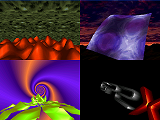
|
It was in 2004 that I've received a Gamepark GP32 from a friend from the demoscene as a present for developing demos and other stuff. I started writting a 3d rasterizer and various effects in my spare time till I decided to release a demo next year. This must be the first time I am writting code for a game handheld. The device has an ARM9 at 133Mhz and 8MB of Ram, no 3d hardware accelerator included. Thus, great effort was put into building a software 3d engine with at least the basic stuff, 3d transformations, vertex lighting, z-buffer and a rasterizer engine for wireframe, flat or gouraud shading and affine texture mapping and then optimized to use fixed point math and avoid division where possible. Effects on this demo range from oldschool stuff like plasma, rotozoomer, tunnel mapping, water effects and juhlia fractals to 3d stuff like vector balls (still retro :), flat/gouraud 3d or enviroment mapped objects. This demo was a great learning curve on how to optimize stuff for limited handheld platforms and how a simple 3d engine works in the core.
Links: download GP32 binary, download PC port, youtube
|
|







